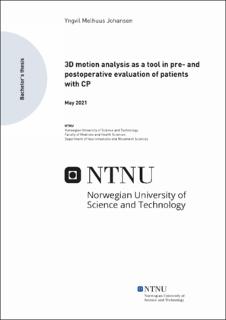| dc.contributor.advisor | Ihlen, Espen Alexander | |
| dc.contributor.author | Johansen, Yngvil Melhuus | |
| dc.date.accessioned | 2021-09-25T16:30:36Z | |
| dc.date.available | 2021-09-25T16:30:36Z | |
| dc.date.issued | 2021 | |
| dc.identifier | no.ntnu:inspera:83417398:83420176 | |
| dc.identifier.uri | https://hdl.handle.net/11250/2783219 | |
| dc.description.abstract | Bakgrunn: Cerebral parese (CP) er en bevegelsesforstyrrelse forårsaket av hjerneskade eller unormal hjerneutvikling i den motoriske korteks før eller kort tid etter fødsel. 3D motion capture-systemer brukes ofte for ganganalyse og blir rapportert som et pålitelig verktøy i preoperativ planlegging og postoperativ evaluering av pasienter med CP. Denne litteraturoversikten hadde følgende spørsmål: På hvilke måter kan 3D bevegelsesanalyse brukes, både pre- og postoperativt, for å evaluere pasienter med CP? Metode: Søkemotorer brukt inkluderte Google Scholar, PubMed, og Oria. Søkeord brukt var “3D motion capture”, “3D gait analysis”, “gait analysis”, “femoral neck anteversion”, “femoral anteversion”, “femoral torsion”, “torsion”, “femoral derotational osteotomy”, “cerebral palsy”, og “accuracy.” Artikler ble inkludert/ekskludert basert på abstrakt, nøkkelord, og titler. Totalt 7 artikler ble inkludert i litteraturoversikten. Resultater: Resultatene viser at 3D motion capture er et allsidig verktøy som kan brukes både for preoperativ planlegging og postoperativ evaluering. 3D motion capture-systemene brukt på sykehus, dog dyre, rapporteres å være nøyaktige og pålitelige. Konklusjon: 3D motion capture er et pålitelig og nyttig verktøy som kan brukes både for å vurdere operasjonsbehov og evaluering av operasjonseffektivitet hos pasienter med CP. | |
| dc.description.abstract | Background: Cerebral palsy (CP) is a movement disorder caused by a brain lesion or abnormal brain development in the motor cortex before or early after birth. 3D motion capture systems are often used for gait analysis in clinical settings, and has been reported as a reliable tool in preoperative planning and postoperative evaluation for patients with CP. This literature review had the following question: In what ways can 3D motion analysis be used, both pre- and postoperatively, to evaluate patients with CP? Method: Search engines included Google Scholar, PubMed, and Oria. Search words used were “3D motion capture”, “3D gait analysis”, “gait analysis”, “femoral neck anteversion”, “femoral anteversion”, “femoral torsion”, “torsion”, “femoral derotational osteotomy”, “cerebral palsy”, and “accuracy.” Articles were included/excluded based on the abstract, keywords, and titles. 7 articles were included in the literature review. Results: Results show 3D motion capture as a versatile tool that can be used both for preoperative planning and postoperative evaluation. The 3D motion capture systems used in hospitals are expensive, but reported to be accurate and reliable. Conclusion: 3D motion analysis is a reliable and useful tool that can be used for assessing surgery needs and evaluating surgery efficacy in patients with CP. | |
| dc.language | eng | |
| dc.publisher | NTNU | |
| dc.title | 3D motion analysis as a tool in pre- and postoperative evaluation of patients with CP | |
| dc.type | Bachelor thesis | |
